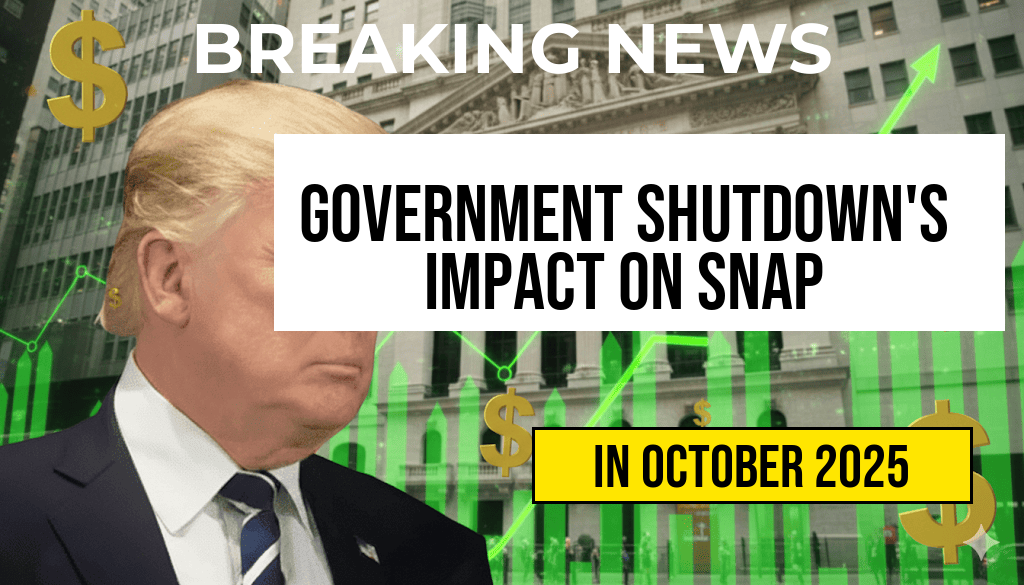The impending government shutdown threatens to disrupt vital social programs across the United States, with Supplemental Nutrition Assistance Program (SNAP) benefits, commonly known as food stamps, among the most affected. As negotiations over federal funding continue without resolution, millions of Americans who rely on SNAP for their daily nutrition face uncertainty. During previous shutdowns, delays in funding led to temporary interruptions in benefit distribution, creating hardship for vulnerable populations. Currently, lawmakers are divided over funding priorities, and unless an agreement is reached, the shutdown could cause significant delays in benefit issuance, potentially impacting millions of households nationwide. This article explores how a government shutdown could impact SNAP benefits, the steps agencies are taking to mitigate effects, and what beneficiaries should expect in the coming weeks.
Impacts of a Government Shutdown on SNAP Benefits
Funding Continuity and Benefit Distribution
SNAP is administered through federal funds allocated annually by Congress. During a government shutdown, the Department of Agriculture (USDA), which oversees SNAP, faces operational challenges due to the furlough of staff and limited administrative resources. Historically, benefit distribution has been affected when federal funding is delayed, leading to the possibility that recipients may not receive their benefits on time or in full. While some states have reserves or carryover funds, these are insufficient to cover prolonged shutdowns, risking gaps in food assistance for vulnerable populations.
Potential Delays and Shortages
- Delayed benefits issuance: Recipients might experience delays in receiving monthly benefits, which are typically distributed via Electronic Benefit Transfer (EBT) cards.
- Reduced benefits or freezes: In some cases, ongoing funding shortages could result in partial benefits or temporary freezes on new applications.
- Impact on vulnerable populations: Children, elderly, and disabled individuals depending on SNAP could face heightened food insecurity if benefits are disrupted.
State-Level Responses and Buffer Strategies
Many states maintain reserve funds or have established contingency plans to continue benefit distribution during federal funding lapses. For example, some state agencies have pledged to prioritize SNAP payments and communicate clearly with recipients about potential delays. However, resources are finite, and the length of a shutdown directly correlates with the severity of disruptions. Recipients are advised to monitor their state’s Department of Social Services website for updates and guidance.
Government Measures to Mitigate the Impact
Automatic Continuation of Benefits
Historically, SNAP benefits have continued during short-term shutdowns because the program operates on funds allocated earlier in the fiscal year. Federal agencies often implement measures to extend benefit periods temporarily, preventing immediate shortages. However, these extensions are not indefinite. If the shutdown extends beyond a few weeks, the risk of benefit interruptions increases significantly.
Legislative Interventions
Lawmakers have occasionally enacted emergency appropriations or temporary funding bills to keep social programs running during shutdowns. For example, during the 2018-2019 shutdown, Congress authorized supplemental funding to ensure continued SNAP benefits. As negotiations continue, some legislators are advocating for similar measures to prevent disruptions, but political disagreements have hindered consensus.
Guidance for SNAP Recipients
| Action | Details |
|---|---|
| Check EBT balance | Monitor your account regularly for any delays or issues. |
| Contact local agency | Reach out to your state’s social services department for updates and guidance. |
| Plan for shortages | Stock up on non-perishable foods if possible, to buffer against potential delays. |
| Stay informed | Follow official channels for announcements related to benefit payments. |
Broader Context and Future Outlook
The potential impact of a government shutdown on food assistance programs underscores broader concerns about social safety nets in times of political uncertainty. Experts warn that prolonged shutdowns can exacerbate food insecurity among low-income households, especially in regions already facing economic challenges. According to the USDA, the SNAP program currently assists over 42 million Americans, many of whom rely on consistent benefits for their daily nutrition (source: Wikipedia).
While legislative efforts continue to avoid a lengthy shutdown, the possibility remains that some recipients will face temporary hardships. Policymakers are urged to prioritize the stability of essential services, including food assistance, to prevent unnecessary suffering among vulnerable populations. As history shows, timely intervention can mitigate the worst effects of such disruptions, but proactive planning remains critical.
Frequently Asked Questions
What is the impact of a government shutdown on SNAP benefits?
During a government shutdown, SNAP benefits may be temporarily halted or reduced, potentially affecting millions of recipients who rely on monthly food assistance. The duration of the shutdown determines how long these benefits are affected.
Will food stamp assistance continue during a government shutdown?
In some cases, food stamp assistance may continue if funding is allocated, but extended shutdowns can disrupt the distribution of benefits, leading to delays or temporary suspensions for recipients.
How can SNAP recipients prepare for a potential shutdown?
Recipients are advised to check their account balances, stock up on essential food items, and stay informed through official government updates to manage their food needs during a shutdown period.
Are there any alternative resources available if SNAP benefits are interrupted?
Yes, food banks and community assistance programs can provide support during disruptions in SNAP benefits. Local organizations often step in to help those affected by government shutdowns.
When will SNAP benefits resume after a government shutdown?
Benefits typically resume once the government reopens and funding is restored. Recipients should monitor official updates for specific timelines and any necessary steps to reactivate their assistance.

Leave a Reply